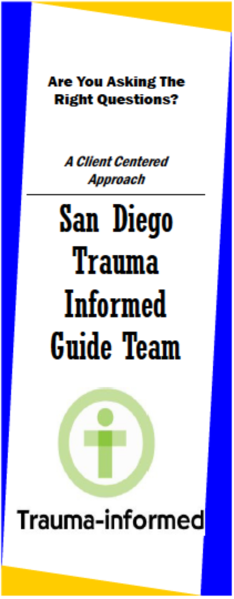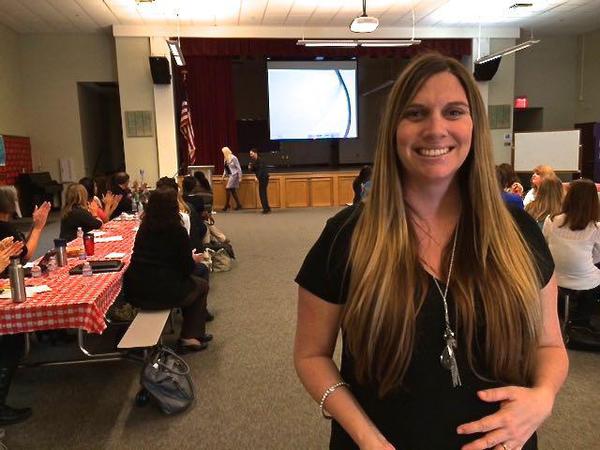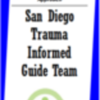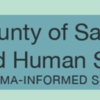T his is a story of how, in six short years, a relatively small group of people inspired, motivated, and induced a community to turn the approach to helping children and adults who experience domestic violence, mental illness, substance abuse, and youth violence upside down and inside out.
his is a story of how, in six short years, a relatively small group of people inspired, motivated, and induced a community to turn the approach to helping children and adults who experience domestic violence, mental illness, substance abuse, and youth violence upside down and inside out.
Specifically, they helped the San Diego social and behavioral health services community integrate the understanding of how childhood adversity figures into all of our social problems, and how trauma-informed and resilience-building practices can solve them. And they did this all on a volunteer basis, with practically no funding, and with the loosest of organizations.
Their impact in a nutshell: Thousands of people in San Diego County now see the world through a trauma-informed lens, and a majority of the leaders of San Diego’s social service organizations are integrating trauma-informed practices.
The San Diego Trauma-Informed Guide Team (SD-TIGT) popped into being in December 2008. Gabriella Grant, director of the California Center of Excellence for Trauma Informed Care, was facilitating a workshop that Dr. Stephanie Covington was giving on ACEs and trauma-informed practices. Covington made it clear that most social service systems, for all their good intentions to help traumatized people, were further traumatizing them. Grant threw out a challenge to the participants: Who wants to do something about this in San Diego? Six people stepped up to talk with her after the training.
Six years later, about 160 people from across San Diego County have joined SD-TIGT. They represent a wide range of organizations, including Harmonium, San Diego County Health and Human Services (HHSA) Behavioral Health Services, San Diego Center for Children, Southern Indian Health Council, and South Bay Community Services.
As the beginnings of creating something out of nothing go, there was the usual flailing. The original six women worked in local social and mental health services – social workers Kimberly Beckstead, Pam Wright and Caroline Atterton; marriage and family therapist Betsy Knight; and managers Amelia Barile-Simon and Debbie Comstock -- had to figure out what “doing something” actually meant.
With technical assistance from OnTrack, they did some strategic planning. They decided that their clients in this endeavor were systems: social services, especially domestic violence; behavioral health services for adults and children; juvenile justice; criminal justice; and education.
They did another workshop with Grant, and developed a plan to take the first step in the process – building awareness of the consequences of adverse childhood experiences (ACEs), and providing information about trauma-informed practices.
ACEs refers to the Kaiser-CDC Adverse Childhood Experiences Study (ACE Study). The study measured 10 types of childhood trauma: sexual, physical and verbal abuse, and physical and emotional neglect; and five types of family dysfunction – witnessing a mother being abused, a household member who’s alcoholic or drug dependent, who’s been imprisoned, or diagnosed with mental illness, or loss of a parent through separation, divorce or other reason. Of course there are other types of trauma -- such as bullying, community violence, homelessness, moving often, racism, and gender discrimination -- but the ACE Study measured only 10.
According to the Substance Abuse and Mental Health Services Administration (SAHMSA), part of the U.S. Department of Health and Human Services, a trauma-informed approach refers to how an organization or community thinks about and responds to children and adults who have experienced or may be at risk for experiencing trauma. In this approach, the whole community understands the prevalence and impact of ACEs, the role trauma plays in people’s lives, and the complex and varied paths for healing and recovery.
A trauma-informed approach asks: “What happened to you?” instead of “What’s wrong with you?” It is designed to avoid re-traumatizing already traumatized people, with a focus on “safety first” (including emotional safety), and a commitment to do no harm.
“We talked a LOT about ACEs,” recalls Beckstead, who at the time ran the older adult program the North Coastal Mental Health Center in Oceanside. She’s now clinical program manager at the Substance Abuse Counseling Center at Marine Corps Air Station Miramar.
The first Friday of every month, they gathered to identify more community partners to invite to the table, to develop a trauma-informed 101 training, and to identify agencies and organizations that might want a workshop.
Among those that signed up were CalFRESH, California’s food-stamp program, which asked the SD-TIGT to train new hires.

“The training rattled their cages,” says Beckstead. “We showed them that ACEs isn’t a “them-us” thing. It’s an “us” thing. We helped them learn how not to trigger themselves or their clients.”
Over the last six years, they’ve done workshops with child welfare workers, nurses, EMTs, police officers, firefighters, mental health workers, and many social service agencies. “For anybody who was interested, if the Guide Team members were willing, we tried to respond to those requests,” says Beckstead.
While Betsy Knight, mental health program manager with HHSA’s Behavioral Health Services, did training for new hires, Barile-Simon, community health promotion specialist at the HHSA Central Region Community Health Action Team (CHAT), and several other SD-TIGT members began training existing staff. Eighty-three percent of CHAT’s 500 staff members were among the first to participate in trauma-informed workshops.
And often they did workshops for the same agency more than once. Because learning about ACEs requires a shift in a person’s mental model of the world – basically, from a punitive approach to changing people’s behavior to a nurturing and solution-oriented approach – people have to hear the information “one or more times to grasp the concept,” says Knight.
Through the next three years, SD-TIGT membership grew and its reach spread. Its two leaders – Beckstead and Knight – never flagged in their commitment. They were motivated by what Knight realized at the December 2008 workshop: As she progressed in her mental health career through domestic violence and mental health services, she was seeing the same people return time and again.
“By the time I was seeing people in the mental health programs, they were older and homeless,” she says. “They’d lost their kids. I could see where some of those children were going to end up as homeless adults. It didn’t matter whether I was working in domestic violence or mental health, I was seeing the same person. They were going through a revolving door, because the first door they came through didn't meet their needs.
“And the commonality with all of them was the horrible situations they encountered, usually as children, that led to domestic violence, substance abuse, physical illness, incarceration,” she continues. “This applied to everybody I'd ever worked with. It made me feel a little better to understand why things weren't progressing for people. It was because we didn’t understand what the real problem was. And now, with this new knowledge, we could serve them better.”
As Beckstead notes: It’s tragic when an 80-year-old woman still has unresolved trauma from being raped 60 years earlier. If she could have received trauma-informed care earlier, “she may have had a completely different life experience,” she says.
By 2012, the team was set in its mission – to promote the development and provision of trauma-informed services in San Diego County’s agencies and systems. Its trauma-informed philosophy was supported by the ACE Study and a dedication to a holistic approach for all consumers regardless of age, race, ethnicity or presenting problem.
They co-sponsored a conference -- Impact of Violence and Trauma in Our Community: Building Effective Community Solutions Conference – with the San Diego County Health and Human Services Agency (HHSA) Department of Behavioral Health Services Mental Health Services Act Prevention and Early Intervention, the
County of San Bernardino Department of Behavioral Health Office of Prevention and Early Intervention, and the Riverside County Department of Mental Health Prevention and Early Intervention. They also helped develop the Building Solutions Toolkit, which was inspired by the conference.
Another way the SD-TIGT had a significant effect was that its members became committed to having their own agencies become trauma-informed.
Stephen Carroll, a division director for homeless/transition age services at San Diego Youth Services joined SD-TIGT in 2010. The agency’s emergency shelter had also brought in Grant to help it being to implement trauma-informed services.
“I got to witness the process,” he says. “I really liked where it was going so I sought out training myself.” He went to a workshop in Birmingham, AL, sponsored by the Family & Youth Services Bureau. “I came out of that saying ‘I get it. This makes total sense for the population we serve.’”
He returned to San Diego and searched for other agencies that were becoming trauma-informed. “I can’t remember how I found SD-TIGT,” he says. “I went to a meeting with the mindset that I was interested in how to transform our agency. That was my primary goal. I found other champions at the county level as well as other nonprofits.”
Through the Guide Team, he found the National Council on Behavioral Health’s Trauma-Informed Learning Communities project. His agency joined the 2011 cohort, and the rest is history.
Participating in the SD-TIGT became part of his job. “I had support from my supervisor, who realized that this was an important piece as an agency making that shift in culture. It was part of my day-to-day responsibilities, which I really appreciated.”
Pam Hansen, director of clinical programs at the San Diego Center for Children (SDCC), joined SD-TIGT in January 2011 after searching the Internet for local resources to help her agency become trauma-informed.
SDCC, which has been in San Diego for 127 years, provides mental health and education services to children and families through outpatient programs, three residential programs, a non-public school, two school-based mental health programs and a countywide wrap-around program. It has 350 employees in eight locations.
“I didn’t know what to do,” she says. “The whole point of joining the Guide Team was to get some direction. I was hoping there’d be some magic formula…three things we could do and we’d be trauma-informed.”
What she learned instead: “You never are there. It’s an ongoing process.”
SDCC participated in the 2012 National Council’s Trauma-Informed Learning Community. “We’ve learned some valuable lessons. You can’t force things on people. Start with the lower hanging fruit and the things that are easiest.” They’ve incorporated a trauma-informed 101 for new hires and are training child care workers in residential programs, and direct-care staff in most of their other programs.
They’ve made some big changes in their residential programs, including eliminating their seclusion rooms. They’re working hard to reduce even further the use of physical holds, and to create environments that don’t trigger traumatized children.
“Are we there yet?” she asks. “No. Have we made great strides in last four or five years? Yes.”
She gives this exampleof how trauma-informed practices work. At one of the residential homes, whenever a 10-year-old girl was triggered, she bolted out the door and ran across streets busy with traffic. “She was too young to verbalize her trauma,” explains Hansen. The traditional response was for a childcare worker to stop her and keep her in physical hold until she calmed down. But that approach just further traumatizes a child.
Based on times when they hadn’t stopped her in time, the workers knew that the girl had run to a nearby park and made a beeline for the swings. So, the next time she took off, staff members tried a different approach. Instead of stopping her, one of the workers walked behind her, followed her to the park, and kept an eye on her while she was swinging. When the girl seemed calmer, the staff member slowly approached her to ask if she was ready to walk back. She nodded, and walked quietly with the adult. On the way back, they talked about how she felt, and explored other ways of dealing with her feelings.
“It built the child’s capacity to self-regulate,” says Hansen, “so that she learned there were other ways of coping besides running away.”
 Rosa Ana Lozada, CEO of Harmonium -- a non-profit organization that reaches more than 30,000 San Dieganseach year through before- and after-school programs, counseling services, and teen programs -- began implementing trauma-informed programs more than 10 years ago. Seeing the benefits, she launched an effort to integrate trauma-informed training for all Harmonium staff members, including people who work directly with Harmonium clients as well as supervisors, administrators and executive staff. Her goal is to create a workplace where everyone "speaks the same language.”
Rosa Ana Lozada, CEO of Harmonium -- a non-profit organization that reaches more than 30,000 San Dieganseach year through before- and after-school programs, counseling services, and teen programs -- began implementing trauma-informed programs more than 10 years ago. Seeing the benefits, she launched an effort to integrate trauma-informed training for all Harmonium staff members, including people who work directly with Harmonium clients as well as supervisors, administrators and executive staff. Her goal is to create a workplace where everyone "speaks the same language.”
"Understanding trauma-informed practices helps us create environments that are welcoming and nonjudgmental," says Lozada. "Are we there yet? No. But we’re striving to get there.”
Lozada is one of the trainers for the county's Probation Department. Once the understanding of trauma-informed care "clicks,” she says, “it changes people’s lenses permanently,” not only in how they work with youth and adults, but how to keep themselves healthy.
Lozada is also chair of the City of San Diego Commission on Gang Prevention and Intervention. She helped the commissioners recognize the value of implementing trauma-informed practices with high-risk youth. Providing trauma-informed training is a goal that's included in the commission's strategic plan for 2015-2017.
The impact that SD-TIGT has had on San Diego County has been “phenomenal”, says Pam Wright, clinical director at South Bay Community Services, which was a pioneer in implementing trauma-informed services in their domestic violence shelters. “People are talking about trauma-informed care, making a shift in their respective agencies and programs and individual people and staff,” she says.
“The Guide Team offered the opportunity for like-minded people who ‘got’ trauma-informed care to support one another and to figure out how to move forward individually, programmatically, and as a community,” she says.
Wright, who was one of the founders of SDTIGT, says becoming trauma-informed has helped change the lives of the people they serve. “So many clients who come through our doors have said to us — you guys are different. Your shelter is different,” she says. “It’s because we’re not trying to be ‘the boss of them’.”
Many women who come to traditional shelters from living with a controlling abuser find themselves mired in another controlling relationship with the staff workers at the shelter. “When they don’t do what the shelter workers tell them to do, the response from the workers feels punitive,” explains Wright. In trauma-informed shelters, clients say they feel as if they have more control over their decisions and lives, and that the shelter workers understand them.
“In terms of the place to go to find other folks who are working on this, to the best of my knowledge, the Guide Team has been ‘it” in San Diego for a long time,” says Carroll. “Kimberly and Betsy have been amazing. Their energy and commitment to the Guide Team has played a big part in maintaining momentum for trauma-informed care in the county.”
Hansen regards SD-TIGT as a great way to share resources. “It’s been a good networking environment where I can compare what I’m doing with other people and to hear what other agencies are doing,” she says. “We’ve moved faster in becoming trauma-informed because of the Guide Team.”
“Part of the beauty of the Guide Team is that it is a grassroots community effort, and they do things because it’s the right thing to do, even without funding,” says Lozada. “It has no restrictions other than to do the work.”
Last year was a turning point for the county. Dr. Dawn Griffin, a forensic psychology professor at Alliant University and president of the San Diego Domestic Violence Council, finished an assessment of the Health and Human Services Agency to determine where trauma-informed practices were being implemented, and what other parts needed to do so.

In July 2014, HHSA issued a policy statement declaring that it was “dedicated to becoming a trauma-informed system”. It founded a working group of trauma-informed “champions” from across the agency to lead the effort.
In the meantime, SD-TIGT is still doing training and encouraging the integration of trauma-informed language in agencies’ and organizations’ strategic plans. They’re also beginning to “look beyond traditional therapy,” says Barile-Simon. “We know that funding is limited for traditional therapy, so we’re trying to identify non-therapeutic methods. We want to know the benefits of yoga, meditation, dancing, singing. How are all these healing the trauma narrative?”
On Thursday, Jan. 28, 2015, about 100 members of the San Diego community are gathering at Cherokee Point Elementary School to celebrate the SD-TIGT and its accomplishments over the last six years, and to launch a larger effort across the county.
Just last week, in the same auditorium, several youth who'd experienced a great deal of adversity in their childhoods, gave presentations at a joint meeting of the city's Human Relations and Gang Prevention and Intervention commissions. They gave compelling accounts of how, with the help of community members, they’d turned their lives around.
“One young woman talked about living in a foster home and suffering a significant level of violence and abuse,” says Lozada. “One young man talked about how his brother had been shot and died. Another young man watched his father be shot and killed. Hearing these stories, people easily could have said, 'That’s what happens when you get in trouble'.”
Instead of being judgmental, says Lozada, the audience, which included the chief of police and the county sheriff, responded with warmth and compassion.
“Trauma-informed is when people behave trauma-informed,” says Lozada. “To see how the commissioners allowed themselvesto hear the youths' stories, to hear their pain and their suffering without judgment, and to offer to serve as a resource for them, that was the moment I knew that trauma-informed practice was working in our community.”






Comments (1)